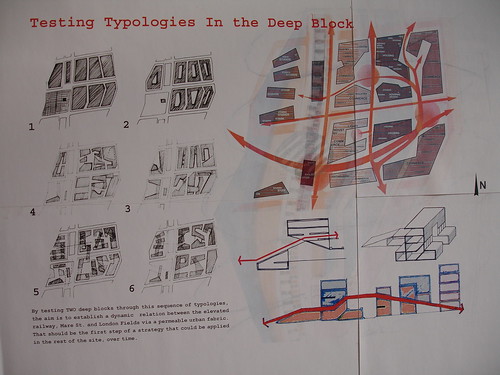Apolonija Sustersic | Community Research Office
At the Architectural Association summer show there was yet another infuriating project concerning the redevelopment of Hackney. I skimmed through it (piles of professionally bound paper) and there were some pretty pictures, but I didn’t see any documentation of dialogue with the community concerned. Not even a questionnaire hand-out. Here’s a spread:

This prompted Jerome to lend me a book: Community Research Office. In 2003 Apolonija Sustersic temporarily converted the IBID gallery on Cambridge Heath road (Hackney) into a CRO with the intention of running a bunch of projects in the space, exploring the different aspects and consequences of gentrification in East London.

In the introduction she says: the gallery white cube gives way to an office space for this work-in-progress. Ultra aware of the role art spaces play in the gentrification process, this isn’t a theoretical exercise. They called it a base for collecting information about the neighbourhood. Sure they start off by quoting Paul Treanor but then the interviews begin: the owner of dairy on Columbia road, Gilda O’Neill on the changes in Roman rd’s Kelly’s Pie and Eel Shop (vegetarian pies? That doesn’t seem right to me.)
Sustersic talks about the problematic nature of housing contemporary art, and how non-contextual spaces offers a poor communication system with the general public. And in relation to gentrification, she makes a point: the young gallery running in a cheap space in the cheapest part of town is not there to revive or communicate with its neighbourhood, but is trying very hard to invite the rich art elite from the other part of town. Vyner street comes to mind.
She mentions the New York-based Center for an Urban Future and their neighbourhood-by-neighbourhood assessment for the potential of arts and culture in stimulating economic growth. Widemar Spruyt talks about urban designers. I like the idea of these people - they are inbetween urban planners and architects. Spruyt - who works for Tower Hamlets Urban Planning Dept - reckons that urban planners are more concerned with social inclusion, and architects with aesthetics and details. He mentions urban design as a growing discipline, working with urban initiatives and re-urbanism, and the urban renaissance as coined by Richard Rogers. The rest of the interviews in the book include Francesca's cafe in Broadway market, the story of York Hall, Bellevue road in Wandsworth. The latter is another story in itself, and Tom Slater (urban geographer) uses it as a case study to underline and group together the various forms of gentrification. In short, this publication is ace.

This prompted Jerome to lend me a book: Community Research Office. In 2003 Apolonija Sustersic temporarily converted the IBID gallery on Cambridge Heath road (Hackney) into a CRO with the intention of running a bunch of projects in the space, exploring the different aspects and consequences of gentrification in East London.

In the introduction she says: the gallery white cube gives way to an office space for this work-in-progress. Ultra aware of the role art spaces play in the gentrification process, this isn’t a theoretical exercise. They called it a base for collecting information about the neighbourhood. Sure they start off by quoting Paul Treanor but then the interviews begin: the owner of dairy on Columbia road, Gilda O’Neill on the changes in Roman rd’s Kelly’s Pie and Eel Shop (vegetarian pies? That doesn’t seem right to me.)
Sustersic talks about the problematic nature of housing contemporary art, and how non-contextual spaces offers a poor communication system with the general public. And in relation to gentrification, she makes a point: the young gallery running in a cheap space in the cheapest part of town is not there to revive or communicate with its neighbourhood, but is trying very hard to invite the rich art elite from the other part of town. Vyner street comes to mind.
She mentions the New York-based Center for an Urban Future and their neighbourhood-by-neighbourhood assessment for the potential of arts and culture in stimulating economic growth. Widemar Spruyt talks about urban designers. I like the idea of these people - they are inbetween urban planners and architects. Spruyt - who works for Tower Hamlets Urban Planning Dept - reckons that urban planners are more concerned with social inclusion, and architects with aesthetics and details. He mentions urban design as a growing discipline, working with urban initiatives and re-urbanism, and the urban renaissance as coined by Richard Rogers. The rest of the interviews in the book include Francesca's cafe in Broadway market, the story of York Hall, Bellevue road in Wandsworth. The latter is another story in itself, and Tom Slater (urban geographer) uses it as a case study to underline and group together the various forms of gentrification. In short, this publication is ace.
Labels: architecture, urbanism

1 Comments:
this is really interesting
Post a Comment
<< Home